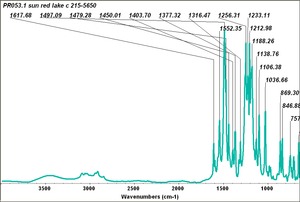Difference between revisions of "Red lake C"
Jump to navigation
Jump to search
m (Text replace - "\[http:\/\/cameo\.mfa\.org\/materials\/fullrecord\.asp\?name=([^\s]+)\s(.*)\]" to "$2") |
|||
| Line 11: | Line 11: | ||
Carcinogen. Toxic by ingestion and inhalation | Carcinogen. Toxic by ingestion and inhalation | ||
| − | [[[SliderGallery rightalign| | + | [[[SliderGallery rightalign|PR053.1 sun red lake c 215-5650.TIF~FTIR (MFA)]]] |
== Additional Information == | == Additional Information == | ||
Revision as of 08:43, 7 January 2020
Description
A red synthetic organic colorant. Red lake C is a Diazo dye that is made by reacting beta-naphthol with the barium salt of o-chloro-m-toluidine-p-sulfonic acid. It was first synthesized in 1902 in Germany. Red lake C is bleed resistant and has better color stability than Lithol red. Red lake C is used as a colorant in plastics, rubber, and printing inks.
Synonyms and Related Terms
Pigment Red 53; CI 15585; D&C Red 9; Clarion red
Hazards and Safety
Carcinogen. Toxic by ingestion and inhalation
Additional Information
B.Berrie, S.Q.Lomax, "Azo Pigments: Their History, Synthesis, Properties and Use in Artists' Materials" in Studies in the History of Art, No.57, National Gallery of Art, Washington DC, 1997.
